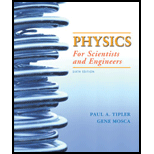
(a)
The volume of gas at A.
(a)
Answer to Problem 78P
The volume at A is
Explanation of Solution
Given:
The pressure at A is
The temperature at A is
Formula used:
The expression for volume at A is given by,
Calculation:
The volume at A is calculated as,
Conclusion:
Therefore, the volume at A is
(b)
The volume and temperature of gas at B.
(b)
Answer to Problem 78P
The volume and temperature at B are
Explanation of Solution
Formula used:
The expression for volume at B is given by,
The expression for temperature at B is given by,
Calculation:
The volume at B is calculated as,
The temperature at B is calculated as,
Conclusion:
Therefore, the volume and temperature at B are
(c)
The temperature of gas at C.
(c)
Answer to Problem 78P
The temperature at C is
Explanation of Solution
Formula used:
The expression for temperature at C as process is isothermal given by,
Calculation:
The temperature at C is calculated as,
Conclusion:
Therefore, the temperature at C is
(d)
The volume of gas at C.
(d)
Answer to Problem 78P
The volume at C is
Explanation of Solution
Formula used:
The expression for volume at C as process is given by,
Calculation:
The volume at C is calculated as,
Conclusion:
Therefore, the volume at C is
(e)
The work done by gas in each segment of cycle.
(e)
Answer to Problem 78P
The work done in process AB, BC and CA are
Explanation of Solution
Formula used:
The work done in process AB is given by,
The expression for work done in process BC is given by,
The expression for work done in process CA is given by,
Calculation:
The work done in process AB is calculated as,
The work done in process BC is calculated as,
The work done in process CA is calculated as,
Conclusion:
Therefore, the work done in process AB, BC and CA are
(f)
The heat absorbed in each segment of cycle.
(f)
Answer to Problem 78P
The heat absorbed in process AB, BC and CA are
Explanation of Solution
Formula used:
The expression for heat absorbed in process AB is given by,
The expression for heat absorbed in process CA is given by,
Calculation:
The heat absorbed in process AB is calculated as,
The heat absorbed in process BC is 0 because the process is adiabatic.
The heat absorbed in process CA is calculated as,
Conclusion:
Therefore, the heat absorbed in process AB, BC and CA are
Want to see more full solutions like this?
Chapter 19 Solutions
Physics For Scientists And Engineers
- The energy output of a heat pump is greater than the energy used to operate the pump. Why doesn't this statement violate the first law of thermodynamics?arrow_forwardA Carnot engine is used to measure the temperature of a heat reservoir. The engine operates between the heat reservoir and a reservoir consisting of water at its triple point. (a) If 400 J per cycle are removed from the heat reservoir while 200 J per cycle are deposited in the triple-point reservoir, what is the temperature of the heat reservoir? (b) If 400 J per cycle are removed from the triple-point reservoir while 200 J per cycle are deposited in the heat reservoir, what is the temperature of the heat reservoir?arrow_forwardA Carnot cycle working between 100 and 30 is used to drive a refrigerator between 10 and 30 . How much energy must the Carnot engine produce per second so that the refrigerator is able to discard 10 J of energy per second?arrow_forward
- Does the entropy increase for a Carnot engine for each cycle?arrow_forwardIn an isochoric process, heat is added to 10 mol of monoatomic ideal gas whose temperature increases from 273 to 373 K. What is the entropy change of the gas?arrow_forwardA Carnot engine operates between 550 and 20 baths and produces 300 kJ of energy in each cycle. Find the change in entropy of the (a) hot bath and (b) cold bath, in each Carnot cycle?arrow_forward
- Two moles of a monatomic ideal gas such as oxygen is compressed adiabatically and reversibly from a state (3 atm, 5 L) to a state with a pressure of 4 atm. (a) Find the volume and temperature of the final state. (b) Find the temperature of the initial state. (c) Find work done by the gas in the process. (d) Find the change in internal energy in the process. Assume Cv=5R and Cp=Cv+R for the diatomic ideal gas in the conditions given.arrow_forwardFor the Carnot cycle of Figure 4.12, what is the entropy change of the hot reservoir, the cold reservoir, and the universe? Figure 4.11 The four processes of the Carnot cycle. The working substance is assumed to be an ideal gas whose thermodynamic path MNOP is represented in Figure 4.12. Figure 4.12 The total work done by the gas in the Carnot cycle is shown and given by the area enclosed by the loop MNOPM.arrow_forwardWhat is the entropy change of 10 g of steam at 100 when it condenses to water at the same temperature?arrow_forward
- A 0.50-kg piece of aluminum at 250 is dropped into 1.0 kg of water at 20 . After equilibrium is reached, what is the net entropy change of the system?arrow_forwardA copper rod of cross-sectional area 5.0 cm2 and length 5.0 m conducts heat from a heat reservoir at 373 K to one at 273 K. What is the time rate of change of the universe's entropy for this process?arrow_forwardIs it possible for a system to have an entropy change if it neither absorbs nor emits heat during a reversible? transition? What happens it the process is irreversible?arrow_forward

 Physics for Scientists and Engineers: Foundations...PhysicsISBN:9781133939146Author:Katz, Debora M.Publisher:Cengage Learning
Physics for Scientists and Engineers: Foundations...PhysicsISBN:9781133939146Author:Katz, Debora M.Publisher:Cengage Learning Principles of Physics: A Calculus-Based TextPhysicsISBN:9781133104261Author:Raymond A. Serway, John W. JewettPublisher:Cengage Learning
Principles of Physics: A Calculus-Based TextPhysicsISBN:9781133104261Author:Raymond A. Serway, John W. JewettPublisher:Cengage Learning


